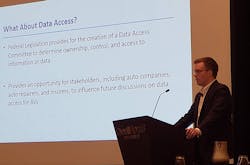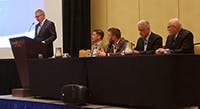ATLANTA — ASA once again hosted its popular Technology and Telematics Forum at the 2018 NACE Automechanika trade show, held at the Georgia World Congress Center August 8-10, in the heart of Atlanta. The six sessions held shared a common theme — the impact Advanced Driver Assist Systems (ADAS) were having on both the collision and mechanical repair industry segments and the path these systems were paving on the road to full autonomy.
Presenters included representatives from Ford, General Motors, VW and Audi as well as leading aftermarket representatives like NASTF Executive Director Donny Seyfer, former ASA Chair Darrell Amberson, and Carquest’s Randy Briggs and Chris Chesney. The sessions were a near equal split between individual presentations and panel discussions that focused on pressing issues facing both collision and mechanical repair business owners, as well as offering observations on what the future may hold for us all.
Here are just a few of the takeaways from these sessions:
From the telematics and claims panel discussion
OEMs and insurers continue to work to become more involved in the collision repair process. The reason is simple and fiscal. Consumers who are dissatisfied with the repairs made to a damaged vehicle are likely to trade in that vehicle for another. Studies have shown that 41 percent of customers unhappy with the repair process were likely to change insurers and 36 percent were likely to change brand of automobile, according to General Motors Collision Wholesale Manager John Eck. That’s a $6 billion market potential for some OEMs – and a potential loss for others. Making sure that the consumer gets a proper and complete repair is vital for insurers and carmakers.
To that end, you’ll see OEMs increase their repair information and training offerings. Eck announced the new GM Certified Collision Repair Network earlier at the show and explained the OEM’s new partnership with Mitchell in providing estimation, repair and parts information in one platform.
Insurance Institute For Highway Safety – Is all this new technology making a difference?
According to David Zuby, Executive Vice President and Chief Research Officer with the Insurance Institute For Highway Safety (IIHS), the short answer is “yes”. Systems that are considered ADAS include forward collision avoidance systems, blind spot monitoring systems and lane departure warning systems. Add in adaptive lighting, and it is expected that the combination of these systems could reduce the U.S. fatality rate by 30 percent.
These systems are already having an impact, with overall accident rates down. However, the severity (damage cost) of the accidents is on the rise with ADAS systems adding an estimated 32 percent to the cost of collision repairs.
Update on federal autonomous vehicle and new vehicle technology policies
The Auto Alliance’s Jeff Beck led off his presentation by sharing two numbers with the audience. The first was 37,461. This is the number of people who died on American roads in 2016. The second number was 94 percent. This is the percentage of those accidents caused by human error or inattentiveness. ADAS is already having an impact on preserving lives once lost to drivers more interested in their cell phones and morning coffee than to the task of driving.
Autonomous cars are another. And they are not that far away from reality, according to Beck, who estimates that SAE Level 3, 4 and 5 cars will be in production within the next five years. (In fact, GM announced earlier this year their intent to put a Level 5 fully autonomous Chevy Bolt into production in 2019. The new car will have no steering wheel or pedals and will be deployed as “ride hailing” vehicles in a number of U.S. cities.)
Beck also shared that it is increasingly important that the Fed sets up legislation and regulatory guidelines for autonomous vehicles before individual states do. If left unchecked, the resulting patchwork of regulations would make it difficult for OEMs to meet varying standards enacted by, as he referred to them, 50 “mini-NHTSAs” (referencing the National Highway and Safety Administration).
Repairs of the future
ASA Washington D.C. representative Bob Redding hosted a discussion featuring a cross generation panel. Participating in the panel were Darrell Amberson (LaMettry’s Collision Centers), Fred Hules (Tech 1 Auto), Brin Kline (Assured Auto Works), and Jake Rodenroth (asTech).
When the panel was asked about the future of the industry, it was interesting to note the varied forecasts offered. Some believed the number of vehicles would decline as autonomous transportation became more widely accepted, with consumers electing to use “ride share” services rather than own their own. But with that, would come even greater needs for maintenance and service as they expected to see these vehicles in use for longer periods of time. Conversely, some of the older panel members felt that, while this may occur in the more congested areas of the country, consumers in general will want to maintain that sense of personal freedom owning a car represented.
ADAS and vehicle calibration
After two short presentations from VW and Audi on their new technologies, NASTF Executive Director Donny Seyfer hosted a panel discussion on the real world challenges ADAS was presenting to collision and mechanical repair shops. The panel was quick to share that following the OEM procedures, especially when it comes to target placement, was critical to insure that the system(s) calibrated properly. Even placing the target a few inches off of the centerline, while possibly allowing the recalibration to be successful, could result in an unwanted ADAS activation. And the only way to know for sure was to perform a test drive and verify proper operation. DTCs will not necessarily be detected or recorded by the system(s).
CTI’s Randy Briggs pointed out another important fact that techs should note. With the integration of other system inputs within ADAS, even routine services and repairs could impact the operation of the system(s). It is more critical than ever to understand how these systems work on the vehicle in your bay, and what needs to be done (if anything) after the service.
Today’s car – Front and center
The last presentation of the day was made by Chris Chesney, Senior Director of Customer Training for Advance Auto. He began by assuring the crowd not to fear the oncoming onslaught of new technology, saying, “We’ve been here before and got through it.” But he did caution attendees, echoing a comment made by GM’s CEO Mary Barra when she observed that we are going to see more technological advances in the automotive industry over the next five years than we’ve seen in the last 50.
The key, Chesney says, is education.
Education is a passion of Chesney’s, and he continued to share his involvement with leading industry groups to revamp our approach to training the next generation. Chesney suggested that “we expect a ’70s education to serve the technology of today.” He went on to state that it was time for the industry to shift to a competency-based education model instead of the current outcome-based model. “The pace of technology change is growing faster than our current education model allows,” Chesney told attendees, and described a new look for training that would include both oral and practical exams to actually certify a student’s ability to perform a task or process.



